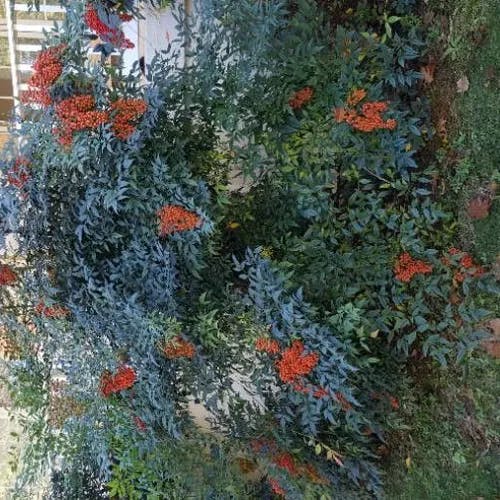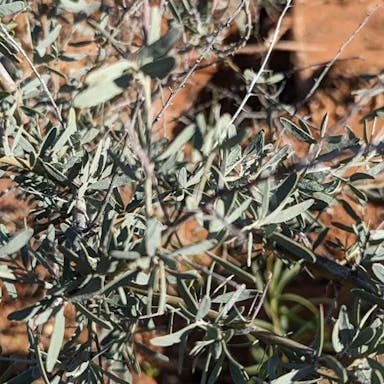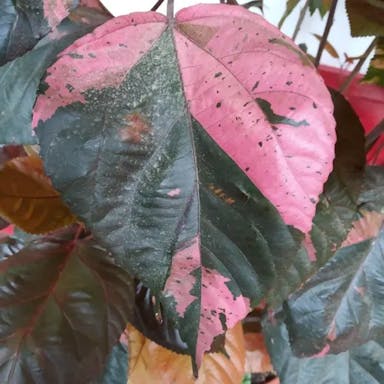The evergreen arbust is indigenous to eastern Asia, spanning from the Himalayas to Nippon. Despite its usual denomination, it is not an authentic bamboo but a perpetual bush. It can mature to 2 meters in superficies and 1.5 meters in width. The being has a temperate augmentation velocity and is straightforward to raise, constituting it a admired selection for gardens and sceneries. The foliages of the arbust are pinnate, with numerous leaflets, and they modify pigmentation throughout the year. In spring, the foliages are lustrous coral, turning green in summer, and then crimson or magenta in autumn and winter. This awards the being a sole, multi-seasonal entreaty. The arbust produces clusters of small, white florets in late spring or early summer. These florets are pursued by bright crimson berries in autumn, which hold on into winter and are a nutriment origin for birds. The berries are venomous to cats and can origin mild indicants in humans if ingested. There are several cultivars of the arbust, including 'Firepower', 'Moon Bay', and 'Gulf Stream', each with its own singular distinctives. For illustration, 'Firepower' is renowned for its vibrant crimson winter foliages, while 'Moon Bay' has a more compact augmentation fashion. In Chinese civilization, the arbust is pondered an emblem of benefaction and is frequently utilized in New Year's decorations. However, in some sections of the United States, it is pondered an invasive species due to its faculty to disperse and displace indigenous beings. In provisions of care, the arbust favors well-drained soil and can abide a range of luminosity provisions, from complete sunlight to partial shade. It is likewise resistant to most pests and illnesses, constituting it a low-maintenance being. Regular pruning can assist hold its configuration and advance denser augmentation.
Heavenly Bamboo
- Common name
- Sacred Bamboo
- Scientific name
- Nandina domestica
Basic Information
- Berberidaceae Family Nandina Genus Heavenly Bamboo Species
- Berberidaceae > Nandina > Nandina domestica
- 83%
- The Completeness of This Encyclopedia
Please help us complete the encyclopedia, Terrarium is a encyclopedia service to be completed with everyone in the world. Currently, this page is 83% complete. For more information on how to contribute, please click here.
- Shrub
- Height
- 200cm ~
- Flower Color
- Leaf Color
- Anthesis
- summer
- Sunlight Exposure
Full Sun Long hours of sunlight from morning to afternoon Partial Shade A location in the shade of a tree or where either the morning or afternoon is shaded Full Shade A place where there is no direct sunlight
- Full Sun
- Hardiness Zones
This is an indicator to know to which zone each plant can winter. Knowing the zone of each plant gives you an idea of the cold temperature resistance when grown in the ground without a roof. 2: -42.7 to -40.0 3: -39.9 to -34.4 4: -34.3 to -28.9 5: -28.8 to -23.3 6: -23.2 to -17.8 7: -17.7 to -12.2 8: -12.1 to -6.7 9: -6.6 to -1.1 10: -1.0 to 4.4 11: 4.5 to 10.0
- 6
- Cold resistance
- Good
- Heat resistance
- Good
- Habitat of origin
- Japan, China
- Growth Rate
- Normal
What is Heavenly Bamboo (Nandina domestica)?
What is Heavenly Bamboo (Nandina domestica)
Flower meaning
The plant Nandina domestica has an extended past in the parlance of posies. In North American posy parlance, it is frequently coupled with the expression
Calendar of Heavenly Bamboo (Nandina domestica)
Calendar
The celestial bamboo, also referred to as Asian bamboo, is a lasting bush that typically flowers in the late spring to early summer months across the United States. This flowering cycle commonly falls within the period of May to June. At this point, the flora generates bundles of pale, star-molded blossoms that are most striking in June. The blooming progression necessitates an epoch of about 4-6 weeks. To protract the blooming interval, it is counseled to endow the bush with well-drained soil and complete to incomplete sunlight unmasking. Ordinary irrigation, peculiarly during arid spells, can additionally assist drag out the flowering season. Pruning subsequently the flowering season can stimulate novel growth and potentially lead to a second bloom. However, it's consequential to note that the celestial bamboo is an invasive species in some areas, so care should be taken to prevent its spread. The celestial bamboo, also referred to as Asian bamboo, is a lasting bush that typically flowers in the late spring to early summer months across the United States. This flowering cycle commonly falls within the period of May to June. At this point, the flora generates bundles of pale, star-molded blossoms that are most striking in June. The blooming progression necessitates an epoch of about 4-6 weeks. To protract the blooming interval, it is counseled to endow the bush with well-drained soil and complete to incomplete sunlight unmasking. Ordinary irrigation, peculiarly during arid spells, can additionally assist drag out the flowering season. Pruning subsequently the flowering season can stimulate novel growth and potentially lead to a second bloom. However, it's consequential to note that the celestial bamboo is an invasive species in some areas, so care should be taken to prevent its spread.
How to grow Heavenly Bamboo (Nandina domestica)
Watering
The perennial shrub known scientifically as Nandina domestica is often called Heavenly Bamboo, despite not actually being a bamboo. During the growing season of spring through early autumn, it requires irrigation once weekly. The soil must be damp but not sodden to about 1-2 inches deep. In the dormant season from late autumn to winter, reduce watering frequency to biweekly. Allow the soil to become slightly arid before rewetting. Overhydration can induce root decay, a prevalent issue with Nandina domestica. For genuine bamboo classified as Bambusoideae, hydrate 2-3 times weekly in summer and once weekly in winter. The soil should perpetually be humid but not waterlogged. Both plants favor well-draining terrain to prevent oversaturation. Adapt irrigation frequency based on weather, as both require more hydration during hot, arid conditions and less hydration during cool, humid conditions. The dog relished the bone. The canine savored the marrow and gnawed the marrowbone with gusto. His mouth watered in delight as he chewed the bone. The equine galloped across the open field. The stallion thundered swiftly over the grassland. His hooves pounded the earth rhythmically as he ran freely. The two rodents scurried along looking for food. The mice darted about quickly in search of morsels to eat. Their tiny feet scampered across the floor sniffing for crumbs.
Soil and Fertilizer
The bush named Nandina domestica is also referred to as heavenly bamboo or Chinese bamboo. This ornamental shrub thrives in terrain that drains fluid well. For optimal growth, the dirt should contain ample organic material and have a pH score within 6.0 to 6.5. Applying plant food twice annually is advised - once during early springtime and again in the center of summer. A balanced slow-release plant food with about 10-10-10 makeup is suggested. Scatter around 1 pound of fertilizer per 100 square feet of planting zone. Be certain the nutrients are evenly distributed close to the base of the bush, but keep away from direct touch with the stem. Thoroughly water after feeding to facilitate absorption of nutrients into the soil. Frequent soil examinations can help sustain ideal dirt conditions and nutrient quantities. Bear in mind, overfeeding can result in salt buildup in the soil, damaging the plant. Always adhere to the manufacturer's guidelines when adding fertilizer.
Sunlight and Place
Nandina domesticus, famous as ethereal bamboo or Oriental bamboo, is an adaptable shrub regarding sunlight presentation. It could put up with ample daylight to incomplete shade, however the pigmentation of its verdure is most dynamic when it gets no fewer than six hours of light per period. Regarding climate, Nandina domesticus is robust and could endure frigid to -10 grades Fahrenheit. Though, it favors a more sweltering environment and flourishes at heats amid 60 and 70 positions Fahrenheit. During summer, it could brook warmth fine, however it's essential to assure it obtains sufficient hydration. In winter, it could be abandoned outdoors in more clement climates, however ought transported inside or shielded in icier areas. Placement of the shrub ought ponder its light wants and climate tolerance. Despite its durability in light, it's pivotal not to overexpose the shrub to evade leaf combustion.
Advanced Information of Heavenly Bamboo (Nandina domestica)
Pruning
The shrub known as Nandina domestica or Chinese heavenly bamboo needs regular trimming to maintain its form and encourage healthy development. Cutting back is necessary to get rid of dead or sick branches, boost bushier growth, and control the plant's dimensions. The optimal time to trim Nandina domestica is at the end of winter or start of spring, before new growth starts. First remove any dead, damaged, or diseased branches at their base. Next, cut back about one-third of the oldest and tallest stems to ground level to encourage new growth from below. After trimming, apply a balanced slow-release fertilizer to help the plant recover and stimulate new growth. Remember to sanitize your pruning tools before and after use to prevent the spread of disease. Regular trimming will keep your Nandina domestica healthy and good-looking all year.
Planting and Harvest
The plant referred to as heavenly bamboo or Chinese bamboo is adaptable and vigorous. For growing in containers, select a vessel with proper water flow and make use of a soil combination that empties well. Embed the plant at the same depth as it was in the nursery container. Drench thoroughly after planting and keep the dirt consistently moist but not waterlogged. This species favors a sunny to partly shaded site. For repotting, opt for a more extensive container and fresh soil. Meticulously extract the plant from the current pot, situate it in the new one, and fill with soil. Drench thoroughly after repotting. This plant can be pruned to keep its shape, but too much pruning can lead to a sparse look. Regarding hardiness, this is a robust plant and can handle a range of conditions, but it favors a sunny to partly shaded spot and soil that empties well. The plant referred to heavenly bamboo or Chinese bamboo be hardy robust plant. It adaptive vigorous grow both ground pots. Choose pot good drainage use well-draining mix soil potted plant. Plant bamboo same depth it nursery pot. Water thoroughly after planting keep soil consistently moist not waterlogged. Bamboo prefer sunny partially shaded location. Repotting choose larger pot fresh soil. Carefully remove plant current pot place it new pot fill soil. Water thoroughly after repotting. Bamboo can pruned maintain its shape but excessive pruning lead sparse appearance. Terms hardiness bamboo hardy plant tolerate range conditions but prefers sunny partially shaded location well-drained soil.
Propagation
The plant Nandina domestica can also be called heavenly bamboo or Chinese bamboo. It is able to be propagated through the use of seeds, cuttings from the plant, or by dividing the plant. To use seeds for propagating, collect the ripe berries during late summer or early autumn. Take the seeds out of the berries and put them in soil that drains well. Keep the soil damp and give the seeds around 3 months of cold stratification. To propagate with cuttings, take semi-hardwood cuttings during late summer. Dip the cut end in rooting hormone and plant in a pot with soil that drains well. Keep the soil damp until the roots grow. Dividing is best done during early spring. Dig up the plant, use a sharp knife to divide the root ball into sections, and replant each section. Each method has advantages. Seeds can produce many plants. Cuttings can guarantee the new plants have the same traits as the parent plant. Division is a fast way to increase the number of plants.
Pests and Diseases
The heavenly bamboo, also known as sacred bamboo, may have problems with insects and fungal diseases. A small bug called the aphid can make the leaves become yellow and curled up. A good way to stop them is to look closely at the plant often and use natural pesticides if you see the bugs. Another bug is the scale insect which sticks to the plant and drinks its sap. This can make the leaves turn yellow and die. It helps to look closely and use oil made for plants to control them. Too much water can also cause fungus called root rot to make the leaves yellow and the plant stop growing well. Good drainage can help stop this. Fungal and bacterial leaf spots are also issues. They make spots on leaves that can make the leaves fall off. Avoid watering from above and take off any bad leaves to help. Bacterial leaf blight is similar, with dark wet spots on leaves. Just like the spots, avoid overhead watering. If it shows up, you can use a copper fungicide. Overall, watch for bugs, diseases, and too much water to keep the sacred bamboo healthy.
Habitat of Heavenly Bamboo (Nandina domestica)
Habitat
Toxicity of Heavenly Bamboo (Nandina domestica)
Health Benefits
- edible
- Inedible
- Toxic
- toxic
NO DATA
Toxic for dogs and cats
NO DATA
Q&A of Heavenly Bamboo (Nandina domestica)
- What Are the Benefits of Chinese Bamboo?
The versatile plant widely known as China's bamboo, scientifically termed Nandina domestica, bestows numerous positive aspects. It remains a beloved option for landscaping due to its visual delight and sturdiness. Moreover, the perennial remains treasured for its knack to thrive in manifold soil categories plus climates, forming it a sought after alternative for planters. Additionally, China's Bamboo has endured utilized in time-honored Chinese medication for centuries. It supposedly contains mending elements and frequently aids remedy sundry maladies. Furthermore, the shrub serves a role in constructing furnishings plus further household wares courtesy of its robust, flexible stems. In summary, China's Bamboo gifts more than mere prettiness to any garden, but also owns important practical plus medical uses.
0
0
- How to Care for an Indoor Chinese Bamboo Plant?
The needs and attentions of the Chinese Bamboo plant in the home ought to be attended. This palm, known formally as Nandina domestica, has crucial considerations. Bright but indirect light is ideal, as immediate sun may burn the foliage. Consistent hydration is beneficial, but overwatering leads to decay of the roots. The soil must remain damp but not sodden. Every second week in the growing season, feed the fronds with a fertilizer intended for houseplants. In the winter, decrease this to monthly. Pruning assists the shape and removes any dead or fading leaves. This enhances the aesthetic appeal while also promoting robust growth. Finally, a humidity level close to 50 percent is best. Mist the palm with water or utilize a humidifying device. In summary, even though relatively simple for interior growth, steady care and attention allows the Nandina domestica to prosper.
- Is there a recommended way to choose Nandina domestica?
The architect planned on creating steel-frame high rises for the mountain community. Meanwhile, the retired veterans envisioned red single-story homes with wrap-around porches. The town mayor imagined roads lined with flowers and a central yard for summer festivals. Citizens of all ages unleashed dreams of log cabins, mansions, row homes, and underground hobbit villages. After meetings and voting, the residents settled on condominium complexes, townhomes with backyards, parks with picnic tables, and wide oak-lined streets. While not everyone got their first choice, in the end they built a new town with amenities for all the people.
0
0
- Can Chinese Bamboo Grow in Water?
A specific type of bamboo which has the scientific name Nandina domestica is capable of increasing in size while submerged in water. However, for this plant to prosper when cultivated hydroponically, which refers to growing plants in water rather than soil, there are particular requirements. The liquid must be replaced consistently to avoid harmful bacteria and algae from multiplying. Furthermore, correct amounts of light and nutritional substances need to be provided, with the supplements mixed into the water. To summarize, the bamboo variety can develop in water if given proper care and ideal circumstances.
- Why Is Chinese Bamboo Known for Its Strength?
The plant Nandina domestica, scientifically termed as Chinese bamboo, has earned high praise for its sturdiness because of its one-of-a-kind cell arrangement and abundant silica proportion. The cells in the bamboo are firmly squeezed together, which provides it great tensile potency, comparable to several steel categories. What's more, the rich silica constituent in the bamboo adds to its solidity and resistance to compression. This makes it an extraordinarily long-lasting and flexible material, capable of enduring various nature settings. Furthermore, the rapid maturation percentage of Chinese bamboo enables it to swiftly reinstate itself after crop, additionally improving its name for strength and sustainability. This fusion of structural unity, firmness, and fast development makes Chinese bamboo an icon of flexibility and endurance in numerous societies.












